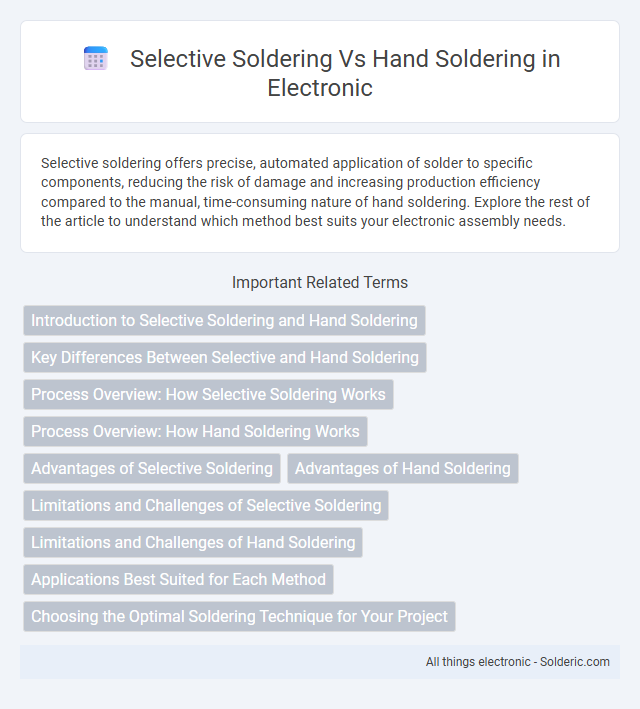Selective soldering offers precise, automated application of solder to specific components, reducing the risk of damage and increasing production efficiency compared to the manual, time-consuming nature of hand soldering. Explore the rest of the article to understand which method best suits your electronic assembly needs.
Comparison Table
| Aspect | Selective Soldering | Hand Soldering |
|---|---|---|
| Process Type | Automated soldering for targeted components | Manual soldering by technician |
| Precision | High precision with controlled solder application | Variable precision based on operator skill |
| Speed | Fast, suitable for medium to high volume production | Slower, ideal for prototyping or small batches |
| Consistency | Consistent solder joints with repeatable quality | Inconsistent due to human variability |
| Cost | Higher initial investment; lower per-unit cost | Low initial cost; higher labor cost per unit |
| Applications | Complex PCBs with mixed components and tight spacing | Simple boards, repairs, or low volume runs |
| Skill Requirement | Requires programming and setup expertise | Requires soldering skill and experience |
| Heat Management | Precise heat control minimizes damage to components | Less controlled heat, risk of thermal damage |
Introduction to Selective Soldering and Hand Soldering
Selective soldering automates the process by precisely applying solder to specific components on a printed circuit board (PCB), ensuring consistent quality and reducing thermal stress on nearby parts. Hand soldering involves manually applying solder with a soldering iron, offering flexibility for small-scale or repair tasks but potentially leading to inconsistent joints and increased risk of damage. Choosing between selective soldering and hand soldering depends on your production volume, complexity, and quality requirements.
Key Differences Between Selective and Hand Soldering
Selective soldering uses automated machinery to precisely apply solder to specific areas on a printed circuit board, ensuring consistent quality and higher production speed, while hand soldering relies on manual skill and tools like soldering irons, resulting in more variability and slower throughput. You benefit from selective soldering in high-volume manufacturing with complex assemblies, whereas hand soldering is suited for prototypes, repairs, and small batches requiring flexibility and direct human control. The key differences include accuracy, repeatability, efficiency, and scalability between the automated selective process and the manual, labor-intensive hand soldering method.
Process Overview: How Selective Soldering Works
Selective soldering uses automated soldering nozzles to precisely apply solder to specific areas on a printed circuit board, minimizing thermal stress and improving consistency. The process involves preheating the PCB, flux application, and controlled immersion of targeted components into a molten solder bath. Your manufacturing efficiency benefits from reduced defects and faster cycle times compared to manual hand soldering.
Process Overview: How Hand Soldering Works
Hand soldering involves manually heating the joint using a soldering iron to melt solder and create a secure electrical connection between components and the PCB. The technician controls the temperature and dwell time to ensure proper solder flow and avoid damage to sensitive components. This process is ideal for small-scale repairs, prototypes, or situations where precise, selective solder application is required.
Advantages of Selective Soldering
Selective soldering offers precise and consistent solder joints, reducing the risk of thermal damage to sensitive components compared to hand soldering. It enhances production efficiency by automating the soldering process, minimizing human error and operational variability. High repeatability and compatibility with complex multi-layer PCBs make selective soldering ideal for mass production in advanced electronics manufacturing.
Advantages of Hand Soldering
Hand soldering offers precise control for delicate or intricate electronic components, allowing skilled technicians to address specific points with accuracy that automated processes may lack. It facilitates rapid prototyping and small-batch production without the need for expensive setup or specialized machinery. The flexibility of hand soldering supports quick adjustments and repairs, making it ideal for custom work and troubleshooting tasks.
Limitations and Challenges of Selective Soldering
Selective soldering faces limitations in handling complex or densely populated PCBs where intricate or small components require precise control that machines may struggle to achieve. Challenges include managing thermal profiles to avoid heat damage, dealing with varying component sizes, and ensuring proper flux application to maintain solder joint quality. Your production process might require additional inspection steps to detect defects like bridging or insufficient solder, which are common in selective soldering.
Limitations and Challenges of Hand Soldering
Hand soldering faces limitations such as inconsistent solder joints, increased risk of thermal damage to components, and operator fatigue affecting precision. The manual process struggles with high-volume production demands and complex PCB layouts, often resulting in lower repeatability and quality control challenges. These issues make selective soldering a preferred choice for reliable, efficient, and automated assembly in modern electronics manufacturing.
Applications Best Suited for Each Method
Selective soldering is ideal for high-volume production and complex circuit boards with dense component placement, ensuring precision and consistency in industrial electronics manufacturing. Hand soldering is best suited for small-scale projects, prototypes, and repair work where flexibility and manual control are essential for delicate or custom tasks. Your choice depends on production scale and component sensitivity, balancing efficiency with precision requirements.
Choosing the Optimal Soldering Technique for Your Project
Selective soldering offers precise, repeatable connections ideal for complex PCB assemblies with mixed through-hole and surface-mount components, reducing thermal stress and improving joint reliability. Hand soldering allows for flexibility and quick adjustments, making it suitable for prototypes, small volumes, or repair tasks but can introduce inconsistency and increased risk of overheating. Selecting the optimal soldering technique depends on production scale, component density, and quality requirements to balance efficiency with craftsmanship.
Selective soldering vs hand soldering Infographic

 solderic.com
solderic.com